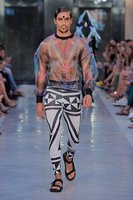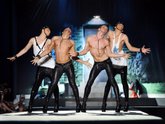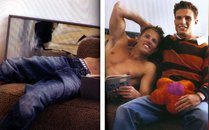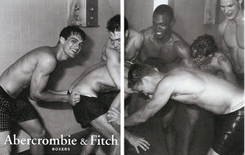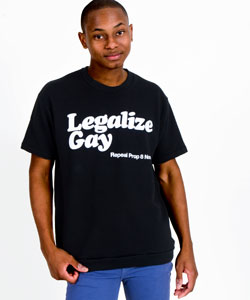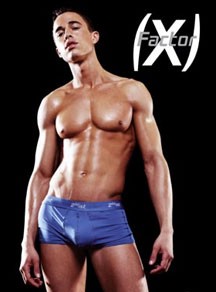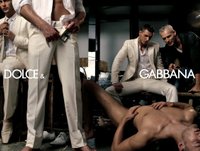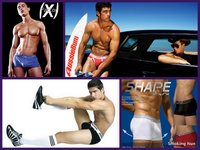Marketing the Rainbow
Click on the pictures for a larger version
Click on the links for case studies
The market
The global apparel market is valued at a whopping $3,000,000,000,000, accounting for 2% of the world's Gross Domestic Product. Taking an average prevalence of 5% of the population, the 'gay fashion market' would be around $150 billion worldwide. Interesting enough to give it special attention.
"Clothing of gay men is a clearly recognized identity to understand personal,
social characteristics, intentions and attitudes."
Association for Consumer Research (ACR)
But more so than for others? Are gays trendsetters, or dedicated followers of fashion? Is the fact that many designers are gay of influence on their target audience? Is fashion gay - or lesbian for that matter?
The ACR called it a Dream Market. A survey was done to provide a better understanding of gay consumers' clothing involvement and fashion consciousness. Surprise: participants indicated that, in general, gay men tend to be more fashion conscious than heterosexual men. However, the study did not provide strong evidence of gay consumers’ involvement in cutting-edge fashion trends.
Names, names, names, sweetie
Sure, some of fashion’s biggest names have been surprisingly straight (Ralph Lauren, Tommy Hilfiger, Giorgio Armani and Oscar de la Renta to name a few), while some, like in the case of Christian Dior, were gay but remained closeted. But there is an unusually high percentage of gay designers among the big names: from Yves Saint-Laurent and Pierre Cardin to Tom Ford and Marc Jacobs, from the Dsquared twins Dean and Dan Caten to Calvin Klein and Michael Kors, the names behind the 2(x)ist and Ginch Gonch brands (maybe less known to the public, but still openly gay), Jean-Paul Gaultier, Karl Lagerfeld, Isaac Mizrahi, John Galliano, Alexander McQueen, Dolce & Gabbana and their compatriots Gianni Versace and Valentino - and lowlanders Edgar Vos, Frans Molenaar, Frank Govers, Dirk Bikkembergs, Walter van Beirendonck and Dries van Noten. And I am not outing anyone if I add these names to the list: Balenciaga, Balmain, Mugler, Halston, Louboutin - although these designers were more active in the higher segment of the market and not so much aiming at the 'ordinary consumers'.
How it is done
How can you reach the gays, and what do you tell - or rather show - them? Dutch fashion group MEXX had included a special segment in their diversity marketing strategy, "Out & Proud": gay men, 20-30 years old, highly style conscious, “discovers” fashion (trendsetting & fashion forward), often dink, very socially active and likely to use word of mouth referals, wielding purchasing power to support brands that support them, will check out any store at least once and fond of European fashions. Now that sums it up quite nicely!
Although not really aiming at the consumer market, the big international fashion weeks are not ashamed to show their rainbow side - it adds to their brand and their fame. First rank seating for the celeb gays, guest performances by the stiletto-heeled Ukranian band Kazaky at the Dsquared show, and gimmicks like a naked fashion show for, eh... male handbags. And of course, the "invitation only" after parties. But I digress.
Sex sells - even gay vague
Many advertisers, among them a lot of fashion brands, use sexy models to sell their products. Some take a controversial approach (like Benetton and Diesel), others a more neutral stance. Despite the omnipresent use of sex to sell their merchandise - sometimes even "forgetting" to include the very clothing they're trying to sell - few fashion brands actually used overtly gay imagery. But designers, including Calvin Klein, Gucci, Versace and Abercrombie & Fitch have teased consumers with so called gay vague imagery (Are they gay? Are they brothers? Are they friends? Are they colleagues? Are they team mates?).
Breaking through
A number of brands have used the gay market to break through, considering the gay consumer to be trendy, perceptive for new hypes and styles, and having a role model function. These advertising campaigns are hardly ever only targeted at the gay or lesbian market: these consumers are just ‘used’ to launch a brand, after which the company hopes to breakthrough in the mainstream market. Some succeeded (Abercrombie & Fitch), some have become successful in the gay market only (2(x)ist, and their spin-off brand C-IN2) - either by choice (Ginch Gonch) or because they could not reach a wider audience.
Shoe brand Timberland allegedly made their breakthrough in the ‘70s and ‘80s thanks to the gay scene, not in the least because the members of the Village People wore them - the brand subsequently crossed over to mainstream in the ‘90s, witnessed by the macho rappers Dr. Dre, Jay-Z and 50 Cent sporting the brand.
A special case: American Apparel
The activities in the LGBT market, be it via sponsoring, advertising or otherwise, is not always directly aimed at sales, but also sometimes carries a political message of support, like in the case of American Apparel - one of the largest apparel manufacturers in North America - in the battle for equality ("Legalize Gay" - after they had run "Legalize LA", a campaign promoting amnesty for illegal immigrants), more specifcally for same-sex marriage and against Prop 8.
In June 2012 American Apparel partnered with GLAAD in releasing a new line of T-shirts to celebrate LGBT Pride Month, donating 15% of the net sales. Isis King modeled for this line, becoming American Apparel's first openly transgender model. In the summer of 2013, American Apparel announced their desire for more "transexy" models. In 2013, American Apparel was named one of TheStreet.com's "8 Pro-Gay Companies."
They made a name for themselves this way, but it could not prevent them from filing for bankruptcy late 2015. They came out of it early 2016, just to apply again in Novembef 2016. Maybe the business plan was not so watertight. See also the separate article about American Apparel.
And then there was Underwear
Although fashion campaigns are often run with (super)models who attract more attention than the product, this is even more so the case with underwear: it gives advertisers the opportunity to show (near) naked (wo)men, all in the name of Fashion. The use of supermodels is not very usual, nor necessary, as a super body is more important.
Echelon magazine explains: “Ever since Calvin Klein’s men’s underwear ads were plastered all over Times Square, in numerous fashion magazines and on television in the 1990s, fashionable men’s underwear has taken a shift from being associated predominantly with the gay community and has found its rightful place within the mainstream men’s market.”
Calvin Klein is often credited with being the first to - successfully - target the gay market. Many followed. Over the last decade, underwear brands such as /baskit/, Andrew Christian, 2(x)ist, Undergear, Hugo Boss, Armani, C-IN2 and Ginch Gonch have gone just as far as Calvin Klein by appealing to both the gay and straight male sensibilities. By creating mainstream advertisements with a gay undertone, or by first building a foundation within the gay community and then branching out into the mainstream men’s market, these companies have seen sales ebb and flow over the last several years.
Since those early days in the 1990s, perhaps fueled by that bold sexuality of CK’s underwear ads, men have been much more comfortable embracing their sexuality in any way they desire to express it. It was Klein’s avantgarde into underwear as “out” wear that catalyzed in younger American men a greater self-awareness of the male form and a newly defined sense of masculinity.
But Marketing the Rainbow definitely played - and plays - in important role in Fashion.
© 2022 BRIGHT Marketing Solutions
